This set of Thermal Engineering Multiple Choice Questions & Answers (MCQs) focuses on “Reaction Turbines – 1”.
1. The magnitude of velocity of steam relative to moving blade in case of an impulse turbine _____
a) always remains constant as steam glides over the blades
b) depending on friction present on the blades, increases or remains constant as the steam glides over the blades
c) depending on friction present on the blades, decreases or remains constant as the steam glides over the blades
d) depending on friction present on the blades, increases or decreases as the steam glides over the blades
View Answer
Explanation: In Impulse turbines the magnitude of velocity of steam relative to the moving blade either remains contant or decreases slightly due to presence of friction on the blades. The ratio of final relative velocity of steam to initial is called the blade velocity coefficient (K).
2. In case of reaction turbines, the magnitude of velocity of steam relative to moving blade increases as the steam progresses.
a) True
b) False
View Answer
Explanation: As the steam flows through the reaction turbine blades, it is continuously expanded. As a result the magnitude of velocity of steam relative to the moving blades increases as the steam flows over the blade.
3. Which of the following expressions for degree of reaction (Rd) of a reaction turbine stage is correct?
a) Rd=\(\frac{Heat \, drop \, in \, moving \, blades}{Heat \, drop \, in \, the \, stage}\)
b) Rd=\(\frac{Heat \, drop \, in \, the \, stage}{Heat \, drop \, in \, moving \, blades}\)
c) Rd=\(\frac{Heat \, drop \, in \, fixed \, blades}{Heat \, drop \, in \, the \, stage}\)
d) Rd=\(\frac{Heat \, drop \, in \, the \, stage}{Heat \, drop \, in \, fixed \, blades}\)
View Answer
Explanation: The degree of reaction (Rd) of a reaction turbine stage is defined as the ratio of heat drop in moving blade to the total heat drop in the stage.
Mathematically,
Rd=\(\frac{Δh_m}{Δh_f+Δh_m} \)
where, Δhm = heat drop in moving blades and
Δhf = heat drop in the fixed blades.
4. Which of the following is the correct formula for calculating the degree of reaction of a reaction turbine?
a) Rd=\(\frac{2C_{bl}(C_{w1}+C_{w2})}{C_{r2}^2-C_{r1}^2} \)
b) Rd=\(\frac{C_{r2}^2-C_{r1}^2}{2C_{bl} (C_{w1}+C_{w2})} \)
c) Rd=\(\frac{C_{bl}(C_{w1}+C_{w2})}{2(C_{r2}^2-C_{r1}^2)} \)
d) Rd=\(\frac{2(C_{r2}^2-C_{r1}^2)}{C_{bl}(C_{w1}+C_{w2})} \)
View Answer
Explanation: We know that,
Rd=\(\frac{Heat \, drop \, in \, moving \, blades}{Heat \, drop \, in \, the \, stage}\)
Since, Heat drop in a moving blade = \(\frac{C_{r2}^2-C_{r1}^2}{2}\), and
Heat drop in the stage = Cbl(Cw1 + CW2)
Therefore, Rd=\(\frac{C_{r2}^2-C_{r1}^2}{2C_{bl} (C_{w1}+C_{w2})} \)
5. The degree of reaction of a Parson’s reaction turbine is _____
a) 0%
b) 25%
c) 50%
d) 100%
View Answer
Explanation: In Parson’s reaction turbine the degree of reaction is 50%. Also in a Parson’s reaction turbine the shape of moving and the fixed blades is same. Due to this the velocity diagram for the blades of this turbine are symmetrical.
6. Which of the following statements does NOT hold true for a Parson’s reaction turbine?
a) α = Ф
b) θ = β
c) C1 = Cr2
d) Cr1 = Cr2
View Answer
Explanation: Parson’s reaction turbine has same shape for moving and fixed baldes. Which implies,
θ = β and α = Ф
Also, C1 = Cr2and C2 = Cr1, which results in a symmetrical velocity diagram.
7. What should be the ratio of blade speed to absolute velocity of steam leaving the nozzle for a Parson’s reaction turbine to work at maximum efficiency?
a) cosα
b) cosβ
c) sinα
d) sinβ
View Answer
Explanation: In a Parson’s reaction turbine, the degree of reaction is 50% and the moving and fixed blades are symmetrical. This turbine works at maximum possible efficiency when the ratio of blade speed to absolute velocity of steam leaving the nozzle is equal to cosine of nozzle angle.
8. The maximum value of efficiency for a Parson’s reaction turbine is _____
a) \(\frac{2(cos)^2}{1+(cos α)^2} \)
b) \(\frac{2(cos α)^2}{1+(cos α)^2} \)
c) \(\frac{1+(cos α)^2}{2(cos α)^2} \)
d) \(\frac{2(cos α)^2}{1+(cos α)^2} \)
View Answer
Explanation: For a Parson’s reaction turbine, the value of maximum efficiency is \(\frac{2(cos α)^2}{1+(cos α)^2} \). This value is achieved when the ratio of blade speed to absolute velocity of steam leaving the nozzle is equal to cosine of nozzle angle.
9. Which of the following velocity diagram ccorresponds to a Parson’s reaction turbine?
a) 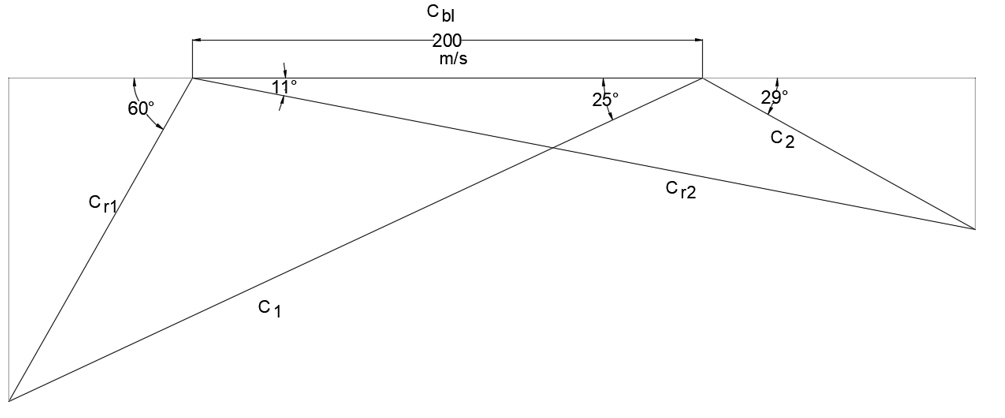
b) 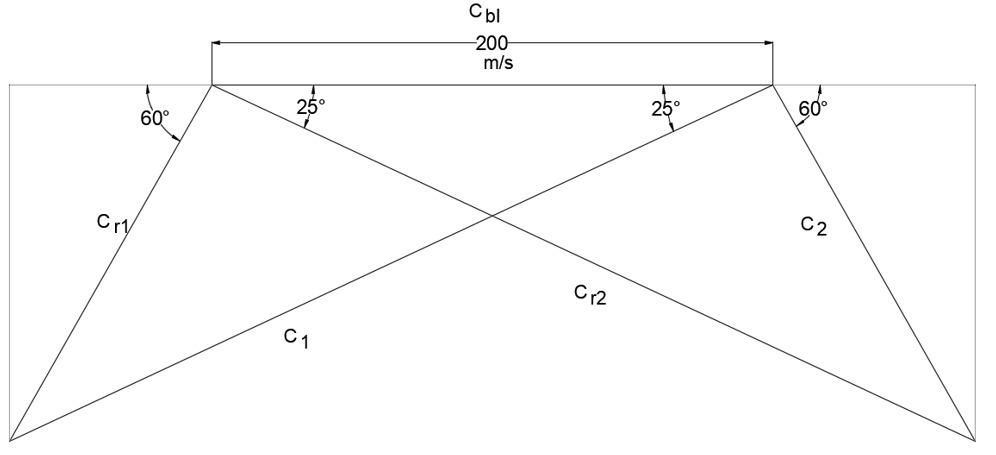
c) 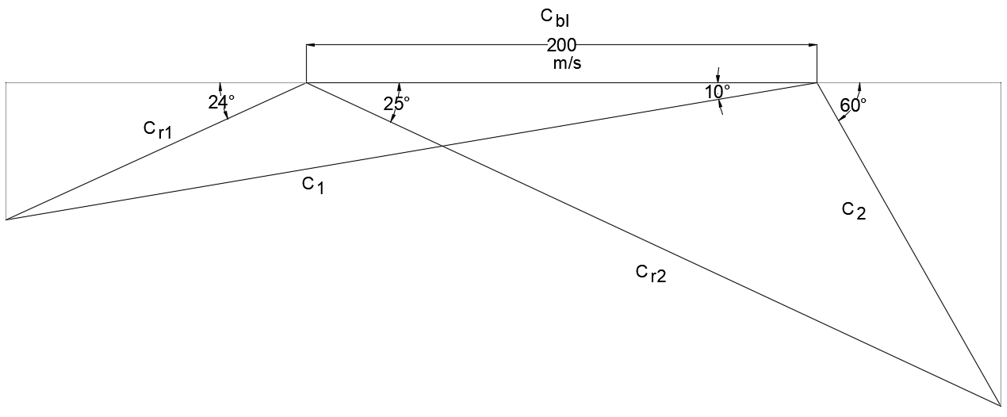
d) 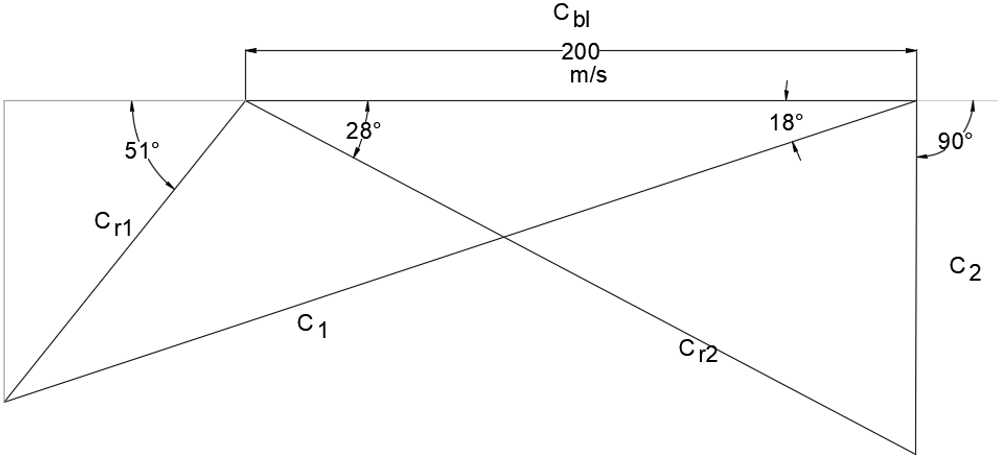
View Answer
Explanation: Parson’s reaction turbine has symmetrical moving and fixed blades which results in a symmetrical velocity diagram. The following properties are observed in a velocity diagram of a Parson’s reaction turbine.
θ = β and α = Ф,
C1 = Cr2and C2 = Cr1
Therefore, the correct answer is

10. The axial force on the blades in Parson’s reaction turbine is always zero.
a) True
b) False
View Answer
Explanation: The velocity diagram of a parson’s reaction turbine is symmetrical, which results in equal flow components of absolute inlet and outlet velocities.
i.e. Cf1 = Cf2
Therefore, axial force on blades = ṁ (Cf1 – Cf2) = 0.
11. The following data refers to a particular stage of a Parson’s reaction turbine:
Mean blade speed = 90 m/s
Velocity of steam leaving the nozzle = 120 m/s
Nozzle angle = 20°
Mass flow rate of steam = 0.8 kg per second
Calculate the tangential force on the blade.
a) 203.54 N
b) 108.42 N
c) 65.32 N
d) 195.45 N
View Answer
Explanation: Cbl= 90 m/s, α = 20°, C1 = 120 m/s, ṁ = 0.8 kg/s
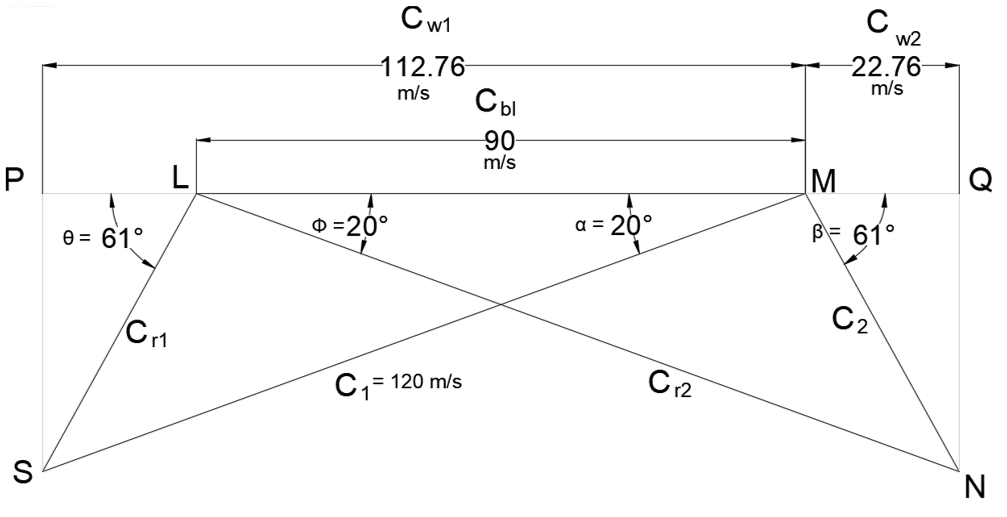
Steps of Construction:
Select a suitable scale and draw a line LM to represent Cbl (=90 m/s).
At point M, at an angle of 20° (α), cut a length MS to represent the velocity C1 (=120 m/s). Join LS. Produce L to meet the perpendicular drawn from S at P. Thus inlet triangle is completed.
For a Parson’s turbine:
Ф = α = 20°
and Cr2=C1 = 120 m/s
At L, at an angle of 20° (Ф), cut a length LN to represent Cr2(=120 m/s). Join MN.
Produce M to meet the perpendicular drawn from N at Q. Thus outlet triangle is completed.
By measurement:
Cw1 = 112.76 m/s and Cw2 = 22.76 m/s
Tangential force = ṁ(Cw1 + Cw2) = 0.8(112.76 + 22.76) = 108.42 N.
12. In a single stage Parson’s reaction turbine, the mean blade velocity is observed to be 60 m/s and the nozzle angle to be 20°. Determine the the entrance angle of moving blade if the absolute velocity of the steam leaving the nozzle is 120 m/s.
a) 38°
b) 56°
c) 23°
d) 28°
View Answer
Explanation: Cbl = 60 m/s, α = 20°, C1 = 120 m/s
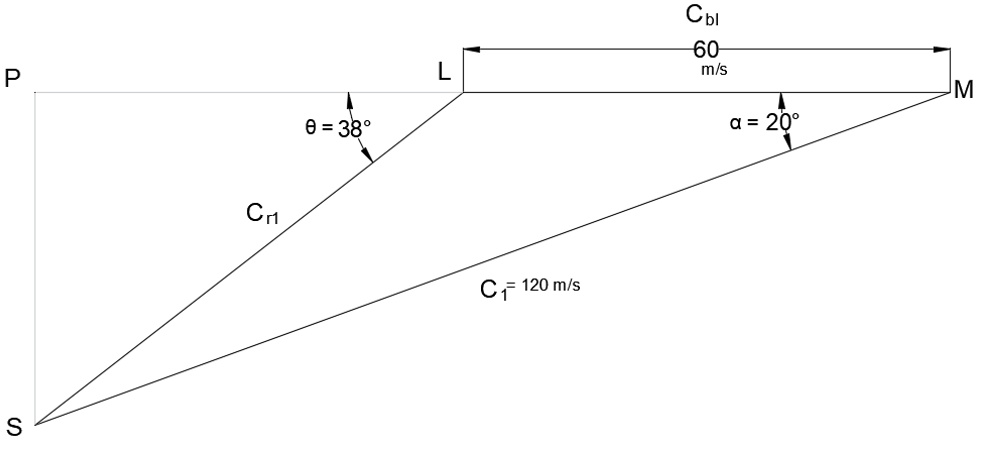
Steps of Construction:
Select a suitable scale and draw a line LM to represent Cbl (=60 m/s).
At point M, at an angle of 20° (α), cut a length MS to represent the velocity C1 (=120 m/s). Join LS. Produce L to meet the perpendicular drawn from S at P. Thus inlet triangle is completed.
By measurement:
θ = 38°.
13. In a reaction turbine, the fixed blades and the moving blades are of the same shape but reversed in direction. The mean blade speed is 30 m/s. The absolute velocity of the steam leaving the nozzle is 90 m/s and the absolute velocity of steam leaving the moving blade is 64 m/s. Determine the nozzle angle.
a) 20°
b) 25°
c) 30°
d) 35°
View Answer
Explanation: Given, Cbl = 30 m/s, C0 = Cr1 = 64 m/s, C1 = 90 m/s
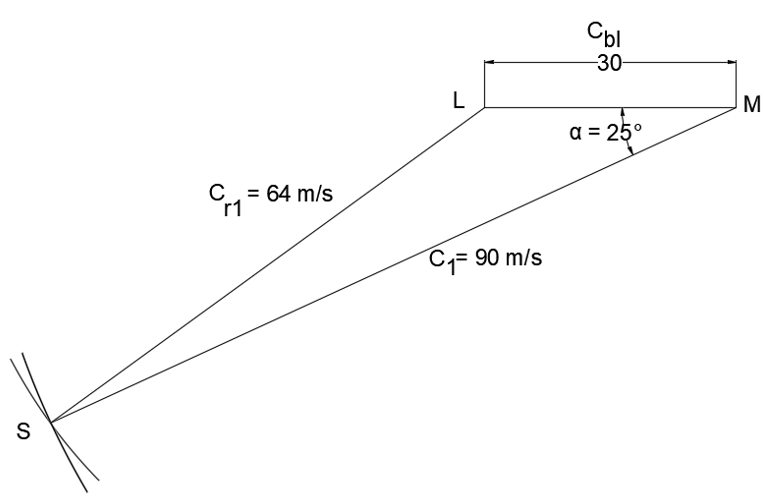
Steps of Construction:
Select a suitable scale and draw a line LM to represent Cbl (= 30 m/s).
At point M, draw an arc of length corresponding to C1 (90 m/s). At point L, draw an arc of length corresponding to length 64 m/s, cutting the previous arc at S. The inlet triangle is complete.
By measurement:
α = ∠LMS = 25°.
14. In a Parson’s reaction turbine, the outlet angle of blade is 25°. Calculate the work done per second by the blades if the blade mean blade speed is 60 m/s and the absolute velocity of the steam leaving the nozzle is 120 m/s. The mass flow rate of steam is 0.1 kg per second.
a) 756 W
b) 854 W
c) 945.12 W
d) 1065 W
View Answer
Explanation: Given, α = Ф = 25°, Cbl = 60 m/s, C1 = 120 m/s, ṁ = 0.1 kg/s
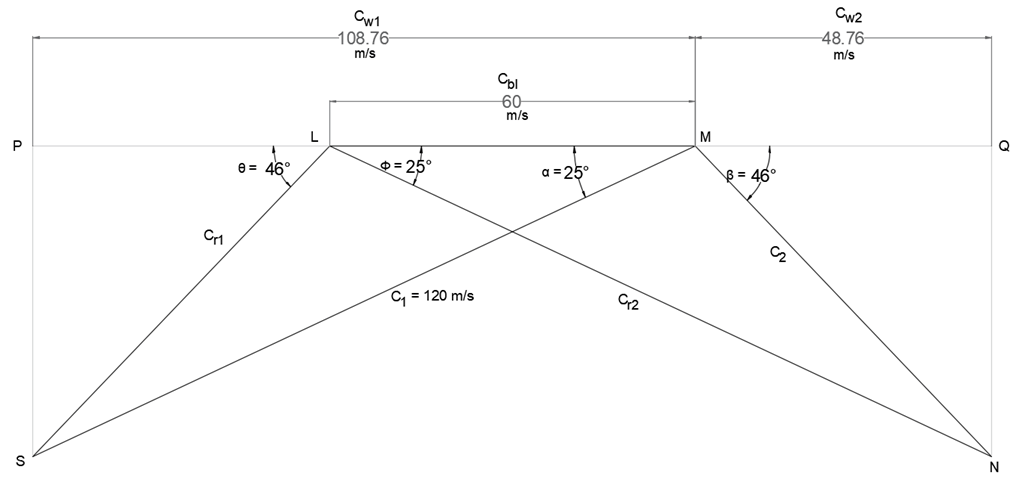
Steps of Construction:
Select a suitable scale and draw a line LM to represent Cbl (= 60 m/s).
At point M, at an angle of 25° (α), cut a length MS to represent the velocity C1 (= 120 m/s). Join LS. Produce L to meet the perpendicular drawn from S at P. Thus inlet triangle is completed.
For a Parson’s turbine:
Ф = α = 25°
and Cr2= C1 = 120 m/s
At L, at an angle of 25° (Ф), cut a length LN to represent Cr2(= 120 m/s). Join MN.
Produce M to meet the perpendicular drawn from N at Q. Thus outlet triangle is completed.
By measurement:
Cw1 = 108.76 m/s and Cw2 = 48.76 m/s
Work done per second = ṁ (Cw1 + Cw2) Cbl = 0.1 (108.76 + 48.76) 60 = 945.12 W.
15. In a single stage reaction turbine, the mean blade velocity is observed to be 200 m/s and the nozzle angle is 20°. The absolute value of the steam leaving the nozzle is 350 m/s. The factor with which the relative velocity of steam changes wit respect to the moving is 2.1. If the moving blade inlet and outlet aangles are equal then calculate the degree of reaction of the turbine.
a) 50%
b) 66%
c) 75%
d) 84%
View Answer
Explanation: Given, Cbl = 200 m/s, α = 20°, C1 = 350 m/s, K = 2.1, θ = Ф
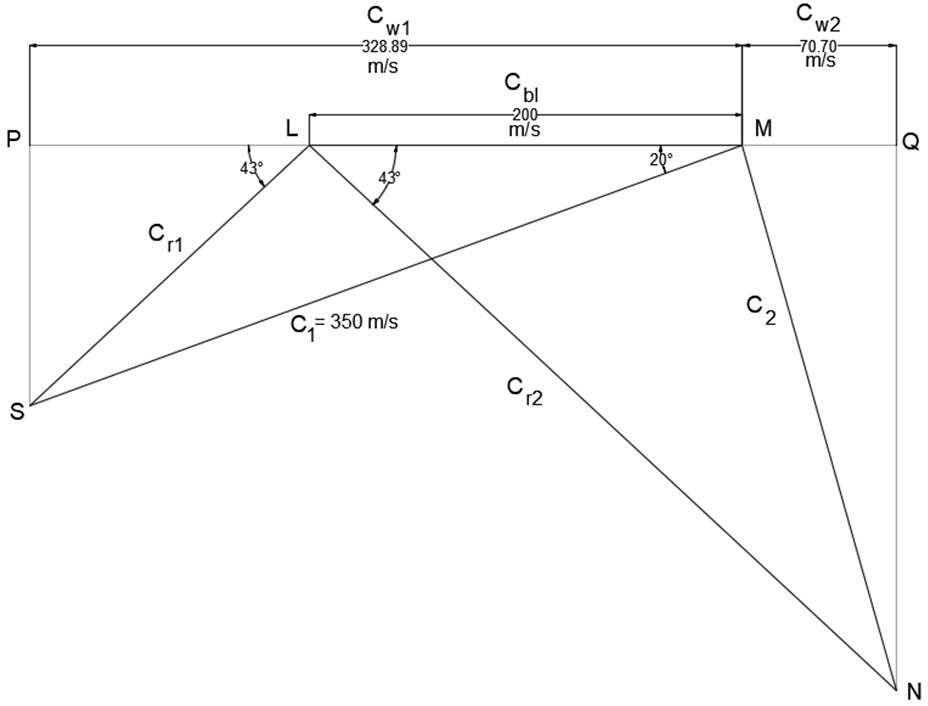
Steps of Construction:
Select a suitable scale and draw a line LM to represent Cbl (= 200 m/s).
At point M, at an angle of 20° (α), cut a length MS to represent the velocity C1 (= 350 m/s). Join LS. Produce L to meet the perpendicular drawn from S at P. Thus inlet triangle is completed.
By measurement:
θ = 43° and Cr1 = 175.91 m/s
It Is givne that, Ф = θ = 43° and Cr2= KCr1 = 2.1 (175.91) = 369.41 m/s
At L, at an angle of 43° (Ф), cut a length LN to represent Cr2(= 369.41 m/s). Join MN.
Produce M to meet the perpendicular drawn from N at Q. Thus outlet triangle is completed.
By measurement:
Cw1 = 328.89 m/s and Cw2 = 70.70 m/s
Degree of Reaction, Rd=\(\frac{C_{r2}^2-C_{r1}^2}{2C_{bl}(C_{w1}+C_{w2})} = \frac{369.41^2-175.91^2}{2*200(328.89+70.70)}\) = 0.66 or 66%.
Sanfoundry Global Education & Learning Series – Thermal Engineering
To practice all areas of Thermal Engineering, here is complete set of 1000+ Multiple Choice Questions and Answers.
If you find a mistake in question / option / answer, kindly take a screenshot and email to [email protected]
- Check Chemical Engineering Books
- Apply for Chemical Engineering Internship
- Practice Chemical Engineering MCQs
- Check Thermal Engineering Books
- Check Mechanical Engineering Books
